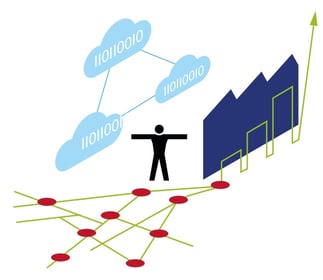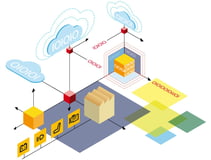How Industry 4.0 Affects Outbound Logistics
Brian Hoey - April 02, 2019

 For most of you reading this right now, it’s early spring. Maybe you’re huddled up inside avoiding cold rains, or maybe it’s just as blustery and wintry outside as it was a few weeks ago. Either way, we’re sure you won’t object if we ask you to pretend it’s summer. More specifically, it’s summer, and you have plans to meet your friends at the beach for a big, old-fashioned picnic. You’re so excited that you spend hours the night before cooking all sorts of classic picnic dishes: potato salad, spinach dip, caprese salad, etc. Unfortunately, you realize at the eleventh hour that you’ve made so much food that you can’t store it all in your fridge. Now, you’re faced with a dilemma. You have to guess which foods won’t spoil if they’re stored at room temperature overnight, and prioritize fridge space for those that won’t. This task is made all the more difficult by the fact that most of the foods are currently stored in opaque containers, meaning that you have to check each container individually to see what’s inside. When your friend texts you to ask how much potato salad you’re bringing, you’re at a complete loss. You have no idea what you have (that’s edible), or what you should transport with you to the beach.
For most of you reading this right now, it’s early spring. Maybe you’re huddled up inside avoiding cold rains, or maybe it’s just as blustery and wintry outside as it was a few weeks ago. Either way, we’re sure you won’t object if we ask you to pretend it’s summer. More specifically, it’s summer, and you have plans to meet your friends at the beach for a big, old-fashioned picnic. You’re so excited that you spend hours the night before cooking all sorts of classic picnic dishes: potato salad, spinach dip, caprese salad, etc. Unfortunately, you realize at the eleventh hour that you’ve made so much food that you can’t store it all in your fridge. Now, you’re faced with a dilemma. You have to guess which foods won’t spoil if they’re stored at room temperature overnight, and prioritize fridge space for those that won’t. This task is made all the more difficult by the fact that most of the foods are currently stored in opaque containers, meaning that you have to check each container individually to see what’s inside. When your friend texts you to ask how much potato salad you’re bringing, you’re at a complete loss. You have no idea what you have (that’s edible), or what you should transport with you to the beach.
How could you have avoided this fate? Sure, you could have tracked your inventory carefully by hand, but who has the time or the inclination? On the other, you could have used a smart fridge—something that will track food as it enters and exits the refrigerator, and can even virtually tag things by date so that you know when they’re likely to go bad. In this scenario, your triage is a breeze, you know exactly what’s in the fridge, and you can transport it to the beach without incident. In this way, it’s a lot like outbound logistics in the era of Industry 4.0.
Slipping Through the Cracks
Unlike inbound logistics, which is all about getting the necessary materials to your production floor in time to adhere to your existing schedules (something which our intrepid chef above seemingly did without incident), outbound logistics flows don’t begin until the moment you have a finished product. At that point, outbound logistics is responsible for storing and eventually transporting those finished goods. The trouble, for many businesses, is that significant disconnect can arise between the factory floor, the warehouse, and your distribution processes—just like we saw in our example above. Modern outbound logistics managers need to keep track of production processes in order to make sure that inventory space is being opened up and allocated appropriately, maintain order in that inventory space in order to keep an accurate accounting of which products are available and which aren’t, and create a synergistic flow that enables easy loading of goods onto trucks for distribution.
Static Transport Routes
Needless to say, a lot can wrong during these processes, and in a non-digital environment it can be especially difficult to keep track of where everything is and where it’s going. Historically, many companies have dealt with this difficulty by arranging a static set of transport routes every day, week, or month. Roughly the same production processes yield roughly the same inventory levels to be distributed in roughly the same way—regardless of changes in demand or market conditions. This might be effective for warding off disruptions, but it also leaves considerable value on the table. Let’s say you’re able to predict in advance that there will be a dip in demand for a particular product: in an ideal world you would change your production ratios to account for this relative demand paucity—but doing so would mean adjusting your inventory strategy to account for the changes and disrupting your traditional transport routes to adjust delivery volumes. This requires an extra round of planning and optimization that can be difficult to carry out without the high level of visibility that tends to come from digitized environments.
The process we described above could lead to added value in the form of outbound logistics management that more accurately meets real demand, but it could just as easily result in confusion, slowdowns, and, ultimately, late deliveries. In this case, your improved predictive capabilities would essentially provide you with no value. So, the question becomes, how can you adapt your workflows such that obviously value-additive processes like better demand management actually result in added value?
Enter Industry 4.0
All of the challenges we’ve been describing have resulted from poor visibility, which in turn led to a subsequent lack of adaptability. On some level, this stands to reason: if you can’t understand what your options are (because you don’t know what resources are where at what time), you can successfully implement any of those options. This is where digitization in general and Industry 4.0 in particular come in. In an Industry 4.0 environment, your factory floor operations are connected via complex digital infrastructure to your inventory management flows. Each finished product and its eventual location within your warehouse is entered in a digital register, such that mission critical information about your holdings can be easily accessed at any time. Yes, this puts you in a position of increased certainty regarding which orders you can fulfill and on what timeline—but it also enables you to provide real-time production feedback based on which items are moving and which aren’t. From there, you can gain the necessary insight into the links between your processes to begin scheduling transport on the fly.
When people talk about Industry 4.0, the rhetoric can often be a bit high-flown. But in the case of outbound logistics, there’s a fairly concrete path forward. Smarter, connected data streams from your factory floor mean more information and more visibility. Those things, in turn, mean that you have the resources you need to begin optimizing your operations more dynamically. All of the pitfalls we described above that come with ditching your static transport options cease to be a problem. Why? Because you can model the effects of any proposed changes based on a digital representation of your real-time factory floor operations. In this way, emerging Industry 4.0 paradigms give you a usable, actionable alternative to a value-killing status quo.
LATEST POSTS
- Understand Circular Economy in The Manufacturing Industry
- How Can Industry 4.0 IT Integration Be Achieved Smoothly?
- The Significance of Order Sequencing in Discrete Manufacturing
- How to improve your Supply Chain Management: The Power of Control Towers
- Optimizing Human Resource Scheduling in Manufacturing: A Technological Approach



